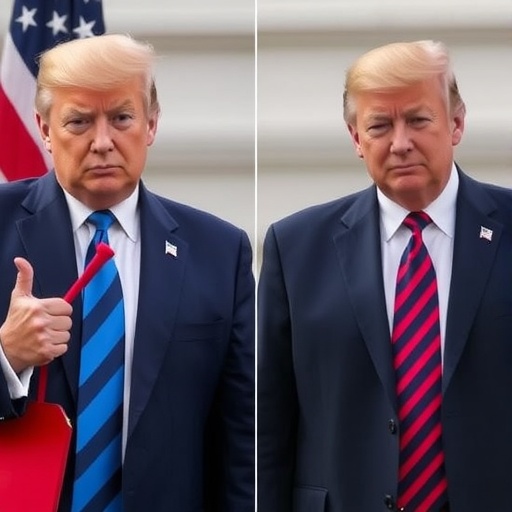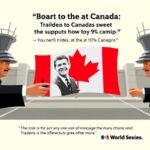Trump Slams Ontario’s Anti-Tariff Ad as ‘Fraud,’ Hikes Duties on Canadian Goods in Escalating Trade Dispute
In a fiery escalation of long-simmering tensions, President Donald Trump has branded an anti-tariff advertisement from Ontario as a blatant ‘fraud’ and swiftly announced an increase in duties on key Canadian goods. The move, which targets imports worth billions, comes just days after the ad aired, criticizing U.S. trade policies and accusing American leaders of economic sabotage against Canada. This latest chapter in the ongoing trade dispute between the U.S. and its northern neighbor risks further straining bilateral relations and could ripple through North American supply chains.
- The Ontario Ad That Ignited Trump’s Tariff Fury
- Trump’s Tariff Escalation Targets Ontario’s Economic Lifelines
- Canadian Leaders Push Back Against Trump’s Trade Dispute Tactics
- Economic Ripples: How Tariffs Threaten North American Supply Chains
- Path Forward: Negotiations and the Future of US-Canada Trade Ties
Trump‘s announcement, made during a press conference at the White House on Thursday, highlighted what he called a ‘serious misrepresentation of the facts’ in the Ontario government’s ad campaign. The 30-second spot, which began airing on major Canadian networks last week, depicted dramatic scenes of shuttered factories and jobless workers in Ontario, attributing the woes to impending U.S. tariffs. ‘This is fake news at its worst,’ Trump declared, vowing to protect American interests by imposing additional tariffs on Canadian aluminum, lumber, and dairy products—staples of Ontario’s export economy.
The decision to raise tariffs from the current 10% to 25% on these Canadian goods is expected to generate an estimated $2.5 billion in additional revenue for the U.S. Treasury annually, according to preliminary figures from the U.S. Trade Representative’s office. However, economists warn that it could lead to higher consumer prices in the U.S. and retaliatory measures from Canada, potentially costing thousands of jobs on both sides of the border.
The Ontario Ad That Ignited Trump’s Tariff Fury
The controversy erupted with the launch of Ontario’s ‘Stand Up to Tariffs’ campaign, a provincial initiative funded by a $5 million budget to rally public support against what Premier Doug Ford described as ‘unfair American trade aggression.’ The ad, narrated by a gravelly-voiced actor portraying a concerned factory worker, opens with sweeping shots of Toronto’s skyline juxtaposed against idle assembly lines in Windsor and Hamilton—key manufacturing hubs reliant on cross-border trade.
‘While Washington plays games with our livelihoods, Ontario stands strong,’ the voiceover intones, blaming Trump-era policies for threatening 150,000 jobs in the province’s auto sector alone. Statistics flashed on screen cite a 2018 trade dispute that saw U.S. tariffs on Canadian steel lead to a 12% drop in Ontario exports to the U.S., valued at over $80 billion annually. The ad ends with a call to action: ‘Tell Ottawa to fight back—before it’s too late.’
Trump, never one to shy away from media skirmishes, took to social media first, tweeting, ‘Ontario’s ad is a fraud designed to deceive Canadians and Americans alike. Their leaders let this lie air while begging for trade deals. Time to make them pay!’ His administration quickly followed up with the tariff hike, framing it as a direct response to what they perceive as provocative misinformation. Canadian media outlets, including CBC and the Toronto Star, reported widespread viewer sympathy for the ad, with a post-airing poll by Angus Reid showing 68% of Ontarians supporting stronger provincial pushback against U.S. tariffs.
Behind the scenes, the ad’s production involved consultations with trade experts from the University of Toronto’s Munk School of Global Affairs, who provided data on how tariffs could exacerbate inflation in Canada by 2-3% if unchecked. Yet, U.S. officials argue that the ad ignores mutual benefits under the USMCA trade agreement, which replaced NAFTA in 2020 and has facilitated $1.2 trillion in annual two-way trade.
Trump’s Tariff Escalation Targets Ontario’s Economic Lifelines
The newly imposed duties strike at the heart of Ontario’s export portfolio, which sends 75% of its goods—totaling $170 billion yearly—to the United States. Aluminum from smelters in Kitimat, indirectly tied to Ontario’s supply chain, now faces a 25% levy, up from 10%, potentially adding $500 million in costs to U.S. manufacturers like Ford and General Motors, both with plants in Ontario.
Lumber, a cornerstone of Canada’s forestry industry with Ontario contributing 20% of national output, sees duties rise to 20%, affecting homebuilders in the U.S. Southwest where Canadian softwood is a primary material. Dairy products, already contentious since the 2018 trade talks, will incur an additional 15% tariff on cheeses and milk powders exported from Ontario’s $4 billion industry, which employs over 10,000 in the province.
White House economic advisor Peter Navarro defended the measures in a briefing, stating, ‘President Trump is calling out the fraud in Ontario’s ad and protecting American workers from subsidized Canadian goods flooding our markets.’ He cited U.S. Department of Commerce data showing Canadian aluminum imports surged 15% in the last quarter, allegedly undercutting domestic producers in states like Ohio and Pennsylvania—key Trump strongholds.
The tariff structure includes phased implementation: immediate 5% hikes effective next week, with full increases by month’s end, allowing time for USMCA review panels to assess compliance. This isn’t the first salvo; recall the 2018 steel tariffs that prompted Canada to retaliate with $12.6 billion in duties on U.S. whiskey, ketchup, and steel pipes, leading to a temporary truce but lingering resentments.
- Key Affected Goods: Aluminum (25% tariff), Softwood Lumber (20%), Dairy (15% additional)
- Estimated U.S. Impact: +$2.5B revenue, but +1.5% rise in construction costs
- Ontario’s Stake: 40% of provincial GDP tied to U.S. exports
Ontario business leaders, including the Canadian Manufacturers & Exporters association, estimate the tariffs could idle 20,000 jobs in the short term, with ripple effects in logistics and retail sectors.
Canadian Leaders Push Back Against Trump’s Trade Dispute Tactics
Premier Doug Ford, whose conservative government spearheaded the ad, fired back at Trump’s accusations during a press scrum in Toronto’s Queen’s Park. ‘Calling our truthful campaign a fraud? That’s rich coming from a president who’s rewritten trade rules to favor his buddies,’ Ford quipped, emphasizing that the ad was vetted by provincial lawyers and based on public data from Statistics Canada.
Federal officials in Ottawa, led by Prime Minister Justin Trudeau, expressed measured concern. In a statement, International Trade Minister Mary Ng said, ‘We regret the escalation but will defend Canadian interests vigorously through WTO channels and bilateral talks. Ontario’s ad highlights real fears—tariffs hurt families on both sides.’ Trudeau’s office has already initiated consultations under the USMCA’s dispute resolution mechanism, which could lead to arbitration if no resolution is reached within 30 days.
The trade dispute has historical roots, dating back to Trump’s first term when he imposed Section 232 tariffs on national security grounds, prompting Canada’s $16.6 billion counter-tariffs on U.S. goods like yogurt from Chobani and motorcycles from Harley-Davidson. A 2019 panel ruled partially in Canada’s favor, lifting some duties, but the aluminum spat reignited in 2020 amid pandemic supply shortages.
Experts like Wendy Dobson, co-director of the Institute for International Business at the University of Toronto, told reporters, ‘This ad was a PR move, but Trump’s response amplifies the political theater. Economically, it’s a lose-lose: U.S. consumers pay more, Canadian exporters lose market share.’ Polling from Nanos Research indicates 55% of Canadians view the U.S. as an unreliable trade partner post-ad, up from 42% last year.
- Federal Response: Ottawa files USMCA complaint
- Provincial Stance: Ford vows no apology for the ad
- Public Sentiment: 62% of Ontarians back anti-tariff campaigns
Amid the rhetoric, quiet diplomacy continues; U.S. Ambassador to Canada David MacNaughton hinted at backchannel talks to avert a full-blown crisis.
Economic Ripples: How Tariffs Threaten North American Supply Chains
Beyond the headlines, the tariff hike on Canadian goods underscores vulnerabilities in integrated North American industries. Ontario’s auto sector, for instance, supplies 20% of U.S. vehicle parts, with just-in-time manufacturing meaning delays could halt lines at Detroit’s Big Three automakers. A study by the Conference Board of Canada projects a 0.5% GDP dip for Ontario and a 0.2% hit to U.S. manufacturing output if tariffs persist.
Broader stats paint a stark picture: U.S.-Canada trade hit $900 billion in 2023, with Ontario accounting for $200 billion. Tariffs could inflate prices for everyday items—think a 5-7% increase in aluminum cans for beverages or higher lumber costs adding $3,000 to the average U.S. home build. Dairy duties might push milk prices up 10 cents per liter in border states like New York and Michigan.
Environmental angles emerge too; increased tariffs on Canadian lumber could accelerate U.S. deforestation pressures, while aluminum levies challenge green energy transitions reliant on Canadian bauxite. Business coalitions, including the U.S. Chamber of Commerce and Canada’s Business Council, issued a joint letter urging de-escalation, warning of ‘unnecessary friction in a post-pandemic recovery.’
Quote from economist Mark Zandi of Moody’s Analytics: ‘Trump’s move is politically motivated, but the economic fallout will be felt from Windsor to Washington. Retaliation could spiral into a 2018 redux, costing $10 billion in lost trade.’
Labor unions on both sides are mobilizing: Unifor in Canada threatens strikes at border plants, while the United Steelworkers in the U.S. praises the tariffs as ‘long-overdue protection.’
Path Forward: Negotiations and the Future of US-Canada Trade Ties
As the dust settles on Trump’s tariff announcement, eyes turn to upcoming summit opportunities. The next USMCA review is slated for 2026, but ad-hoc talks could convene sooner, perhaps at the G7 in Italy this summer. Canadian diplomats are pushing for exemptions on critical minerals like nickel from Ontario mines, vital for U.S. EV battery production under the Inflation Reduction Act.
Trump’s team signals openness to deals if Canada reins in what they call ‘subsidized ads and unfair practices.’ Ford has floated a provincial-U.S. state compact, similar to past Great Lakes agreements, to bypass federal gridlock. Analysts predict a 60% chance of partial rollback if negotiations yield concessions, such as increased U.S. dairy market access for Canada.
Long-term, this trade dispute highlights fractures in North American resilience against global competitors like China, whose steel exports have doubled since 2020. With elections looming—Trump eyeing 2024, Trudeau facing a 2025 vote—the political stakes could either force compromise or harden lines. For now, businesses from Buffalo to Barrie brace for uncertainty, hoping rhetoric gives way to reason before costs mount further.
In the words of trade veteran Laura Bipes from the Wilson Center, ‘This isn’t just about an ad; it’s a test of whether the world’s closest economic partners can navigate populism without derailing prosperity.’ As tariffs take effect, stakeholders on both sides watch closely for the next move in this high-stakes border ballet.










